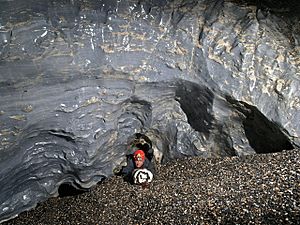Nettlebed Cave facts for kids


Nettlebed Cave is a huge cave made of limestone. You can find it in the Mount Arthur area, which is in the northwest part of the South Island of New Zealand. The cave gets its name from a special plant called ongaonga (Urtica ferox). This plant is a type of tree nettle that only grows in New Zealand, and it's found near the cave's lower entrance.
For a while, Nettlebed Cave was thought to be the deepest cave in the southern half of the world. But in April 2010, another cave system nearby, called Ellis Basin cave system, was found to be even deeper. Nettlebed Cave goes down 889 metres from its top entrance, known as Blizzard Pot. Its water eventually comes out at the Pearse River resurgence. With about 24 kilometres of passages, it's also the third longest cave in New Zealand.
In January 2014, a group of cave explorers found a connection between Nettlebed Cave and another cave called Stormy Pot Cave. This made the whole system even bigger!
Exploring Nettlebed Cave
People first started exploring Nettlebed Cave in 1969. They went in through a dry passage where a large spring usually flowed into the Pearse River. By 1973, explorers had mapped out 1.3 kilometres of the cave.
Breaking Through Barriers
A big step happened in 1979 when cavers managed to get past a very tight spot called the Hinkle-horn-honking-holes. This tight squeeze was made of flowstone, which is a type of rock formation. Getting past it opened up many more parts of the cave to explore.
Over the next few years, from 1979 to 1984, groups of explorers went on five big trips during Christmas. They even set up camps underground, calling them Salvation Hall and Soft Rock Cafe. During these trips, they explored and mapped out another 20 kilometres of passages!
Connecting to Other Caves
In 1986, another cave called Blizzard Pot was found to connect with Nettlebed Cave. This gave the system an upper entrance. It also made the total depth of the cave system 889 metres, measured from the highest point in Blizzard Pot to the deepest part of Nettlebed Cave.
A long-awaited connection between Nettlebed and Stormy Pot was finally made on February 29, 2014. This happened after a week-long camp at Soft Rock Cafe. Explorers had used a smoke test to guess where the connection might be. A team of four cavers – Kieran McKay, Bruce Mutton, Gavin Holden, and Jonathan Ravens – dug through a pile of rocks in a narrow crack. They reached the bottom of a small, muddy shaft. They made a tight squeeze a bit wider with a rock hammer, and then they were in Stormy Pot!
After this connection, the total depth of the combined Nettlebed/Stormy Pot system was measured. From the top entrance, Big Friendly Giant, to the deepest point in Nettlebed's Midas Chambers, it's 1180 metres deep! This measurement was confirmed in December 2015 using accurate GPS. As of December 2019, the total mapped length of the Nettlebed/Stormy Pot system is nearly 48 kilometres (47,969.7 metres).
Pearse Resurgence: Where the Water Comes Out
The Pearse Resurgence is where the Pearse Stream begins. It's also the point where all the water from caves on Mount Arthur, including Nettlebed Cave, flows out. Scientists have confirmed this by putting special dyes into other caves like Ellis Basin and Windrift. The dyes then showed up in the Pearse Resurgence.
Deep Diving Records
The Pearse Resurgence is also famous for its deep cave diving.
- On March 21, 2007, a team of international cave divers set a New Zealand record. They reached a depth of 177 metres (581 feet below ground) in the Pearse Resurgence.
- In 2011, divers went even deeper, reaching 194 metres. They used special decompression habitats along the main tunnel to help them breathe safely. However, they still couldn't find the exact source of the water.
- During the 2014 Wet Mules diving trip, divers pushed the record even further, reaching a depth of 217 metres.
- In 2016, Richard Harris and Dave Hurst explored a passage called "Second Breakfast." They made a 13-hour dive and reached a depth of 229 metres! They had to turn back when their lights started to have problems.

